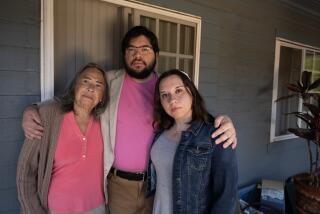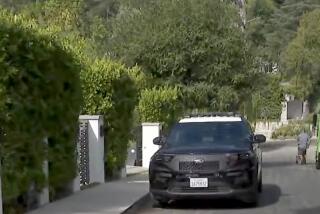Taking Back Turf : Former Farm Labor Camp Cabrillo Village Reports Success Against Gangs
- Share via
VENTURA — For years Cabrillo Village was at the end of the road, on the other side of the tracks, its low roofs hidden from sight among a sea of lemon trees.
By the late 1980s, violence stalked the streets. It peaked in 1991 when outside gang members sprayed bullets into a baptismal party, killing two young men in the middle of the morning.
Now, three years after being annexed by the city, the Mexican-style village cooperative that was once a farm camp has been swallowed whole. Suburban housing tracts press up against Cabrillo Village on three sides. The river bottom and federal flood plain block it on the fourth.
With added pressure from the influx of residents from surrounding cookie-cutter developments, Ventura police officers have worked with the management of Cabrillo Village to take back the streets from local gangs.
The struggle is far from over, but police and residents alike hail it as a success.
Village residents are again strolling in the evenings. Fences are freshly painted, free of graffiti. Cabrillo Village has set up its own Neighborhood Watch group, and in May a new center opened for police and residents to stop and chat and drink coffee.
“Before, when you heard a car, it was like, you gotta find out who it is,” said Oralia Acuna, who used to cower in the darkness when an unfamiliar vehicle approached. “I’d walk back from my mom’s house and think, ‘Oh, my God. Is someone going to do a drive-by?’ But there has been a dramatic improvement.”
Adds Neal Glisson Jr., who lives across the tracks in a nearby tract home: “They have made a lot of improvements in recent years. I get the sense that they are really trying to pull together.”
But the battle to retake the streets has come at a price--too high for some.
Working with Ventura police, the cooperative’s board of directors and its executive director, Hal Slade, have a bold and controversial weapon in the battle against the gangs: They evict the most violent gang members from Cabrillo Village and their families too.
Cabrillo residents praise Slade for his work and laud the police for their quick response and constant presence.
But the evicted families tell a different story. Bitterly, they speak of a racist, domineering director who runs the village like a police state, throwing families out without evidence of wrongdoing. And they tell tales of police who circle their streets endlessly, harassing local youths.
A Village With a Unique History
Passing into Cabrillo Village from encroaching suburbia is like entering another world. The streets are narrow, the houses small. A tiny grocery store sells Mexican spices and vegetables and Pepsi, bottled in Mexico.
Sunflowers, cactuses and well-tended fruit trees cluster around the original homes.
On a recent summer evening, children played in the streets, and mariachi music drifted lazily through screen doors. Men, their faces dark and leathery from work in the fields, leaned up against walls, smoking.
Things were not always so tranquil.
Over the years, Cabrillo Village has faced more than its share of troubles. And the residents are used to standing together to take care of their own.
The village began as a labor camp in 1936, when the Saticoy Lemon Growers Assn. built it to shelter its Mexican farm workers.
By 1975, the growers faced so many code violations for the flimsy, rundown shacks, that they offered workers $500 apiece to evacuate the homes so they could be demolished.
Desperate to save their community, the farm workers called in Cesar Chavez, the charismatic president of the United Farm Workers Union. As the bulldozers rumbled up to their homes Nov. 24, 1975, the workers linked arms in a protective human chain.
The tense standoff lasted throughout the day. In the end, the bulldozers backed down.
Joined in solidarity, the original 80 families of Cabrillo Village pooled their money and bought their homes and the land beneath them for a $80,000 total.
It was the first time in the nation’s history that Mexican American farm workers had bought their homes from a grower, residents say. The courageous act captured national attention. A 1970s TV news documentary recorded the tale of their struggle.
Afterward, however, Cabrillo turned in upon itself. The tiny tight-knit community where families greet each other by first name faced a new threat from within.
*
The village of 1,000 residents became a virtual war zone. Local gang members terrorized residents and kept them silent through threats of retaliation.
“At night, the streets are all ours,” Campos gang member Gerardo Oseguera boasted in an interview in January 1995. “Yeah, the adults, they call each other on the phones at night. ‘Oh look out, they’re coming this way,’ ” he said, mimicking a woman’s high-pitched voice. “But they know where we live and we know where they live. So they can’t rat on us.”
Outside the Ventura city limits until late 1994, Cabrillo Village fell under the jurisdiction of the county sheriff, whose deputies are spread countywide. When violence erupted, response time was slow. Residents largely had to fend for themselves.
“By the time they got here it was all over,” said Hector Lopez, 38. “People decided, ‘Why even call the police? They never come anyway.’ ”
People retreated into their homes, silent and scared.
“People got used to hearing shots along the river bottom, to kids drinking, to cars racing up and down,” said Ventura Police Det. Rafael Martinez, who grew up in Cabrillo Village. “It began to be an everyday occurrence.”
Annexed by Ventura
Annexation by the city of Ventura in 1994 changed all of that, paving the way for new development.
“Cabrillo was an island of unincorporated property surrounded by the city,” said Everett Millais, the city’s director of community services. “Developers were proposing to blanket the area further, so we had to annex.”
The annexation came just as the city was cutting personnel across the board, including the Police Department, Lt. Carl Handy said.
“We had a concern . . . that there would be an increased workload for the Police Department,” he said. “And frankly that turned out to be true.”
Annexation brought Ventura police. And the development that sprouted up around Cabrillo, paving over the orchards, brought new eyes and ears, unaccustomed to gunshots and drive-bys--and unwilling to put up with it.
Rather than harboring resentment toward the developments that now hem them in on three sides, many villagers say they are grateful for the increased attention.
“They don’t take any abuse,” Lopez said, referring to the suburbanites living in nearby developments. “When they hear something, they call the police.”
Leo Castillo gestured at the windows and rooftops that peer down into the village from above. “They are more expensive, better homes,” he said. “They have more influence. They put more pressure on us. . . . We needed that.”
Police Seek Community’s Trust
Immediately following annexation, Ventura police officers launched an ambitious program to earn the trust of residents, who must abide by city laws as well as the cooperative’s bylaws.
Det. Martinez explained that linguistic and cultural barriers prevented villagers from turning to outsiders for help. People feared that if they called 911 no one would understand.
There was a hope, Martinez said, that families would take care of problems internally. But that was not happening.
Police set up a mobile police station, began regular patrols and brought in bilingual officers. They initiated a community outreach program to make officers more accessible.
“We were struggling with cultural issues,” said Sgt. Bob Anderson, who helped supervise the Cabrillo Village operation. “They were taught to remain silent. They don’t get involved. They don’t stand up as witnesses. To get them to adopt [our] philosophy to better themselves as a community is a tough lesson.”
*
Eighteen months ago, residents set up a Neighborhood Watch group. On May 9, Cabrillo Village opened what is now the Saul Martinez Resource Center, a small cozy room by the front entrance of the village where police and residents drop by. It’s open until midnight on weekends, staffed by village volunteers.
Neighborhood Watch meetings are held in the home of J.J. Vaivao, who is regarded as the heartbeat of the group, and the Pied Piper of programs to help local youth. With 40 regular members, Sgt. Anderson reports that the fledgling Neighborhood Watch group is the largest one in town.
The Police Department also began work with Slade and the village board of directors to identify and target serious offenders, including gang members.
“We took those who were terrorizing the community, and if we were unable to control them, we assisted the management in evicting those families,” Lt. Handy said.
To date, seven families have been evicted, including one of the founding 80 families and another with a seat on the village’s board of directors.
Fashioned as a cooperative, residents pay $1,000 for a membership into the housing association, but they never own a specific unit or claim individual property rights. As members of the cooperative, residents must also abide by the village bylaws, which state that they cannot seriously disrupt the community. If they do, they can be evicted.
Police and many residents call the eviction policy the key to regaining control of the streets. But they also say the policy has divided the village.
“That’s been a real controversial issue out there,” Anderson said. “The management at Cabrillo Village has taken a strong and innovative position that we are going to remove the problem families one at a time.”
Indeed, the evicted families are now scattered among other communities in Oxnard and Santa Paula.
On a recent evening, several of them gathered in Oxnard at the home of the Martinez family. The six-member Martinez family was evicted en masse in 1996 because one son allegedly shot off a gun in the Ventura River bottom and later beat a village resident.
“That was the kicker,” Slade said.
*
Carlos Martinez, the head of the household, is a quiet man who has spent most of his life in orchards picking lemons. He lived in the village for more than 30 years and joined hands with his neighbors more than 20 years ago when they linked arms to block the bulldozers.
“That place was my life,” said Martinez sadly, over the drone of the television. “I worked to make it what it is today. My children grew up there. Now this dictator comes along and I and my family are out.”
Isolated from family and friends, the outcast families complain that the eviction policy has been selectively applied and unfairly enforced.
“Years ago, people used to drink in the streets. Families fought. No one was ever evicted,” said Olga Martinez, the family’s matriarch.
They claim Slade carried out his cleanup policies through threats and intimidation.
“I never threaten anyone,” said Slade, who was once punched in the face by a member of one of first families to be evicted.
Slade measures his support by those who inform him about problem villagers. “They are not given a reward,” he said. “It is done because people are committed to having a better life in the community and they are tired of violence.”
Furthermore, he said, the seven families were evicted only after repeated warnings--except in cases in which the act was especially grievous.
“They were given notice after notice,” Slade said of those booted from the village. “It’s not like they woke up one morning and this happened. By the time they had guns, or were beating people . . . then they have to pack their bags.”
Yet critics say the eviction policy does not keep the troublemakers out.
“They didn’t accomplish anything,” said Carlos Martinez Jr. He said his brother, who prompted the family’s eviction, often returns to the village to see his friends.
“If it’s the kids they were scared of, they’re still there. It’s the parents that suffer.”
*
Anderson acknowledges that some gang members “have filtered back in again,” to the neighborhood.
“But when families saw that they could be evicted it sent a strong message,” he said. Many families, he said, have taken a stronger role in controlling their teenagers.
And the eviction policy has some ardent backers. Claudio Ramirez, whose son Javier was killed in 1991 in a drive-by shooting, was a strong advocate for evictions during his tenure on the board of directors.
“We have rules and regulations we have to follow,” Ramirez said. The families, he said, “haven’t been dismissed because we don’t like them, because we don’t like the families. It’s because they have gang members.”
Lawyers for one of the evicted families have argued that much of the violence has not occurred within the perimeter of Cabrillo Village.
But Slade points out that when gang members use Cabrillo as their home base, gang members from outside converge on the village to strike at their Cabrillo rivals.
“They are a magnet for violence,” he said of village gang members. “When we get those families out, there is not going to be a draw for other outside gang members to come here.”
A Safer Place to Live
Despite the debate over the evictions, few dispute that the village is now safer. Gang activity is down.
Although there are no separate crime statistics compiled for Cabrillo Village, Ventura police have reported no slayings since a 37-year-old father of four was struck by a stray bullet as he left an Alcoholics Anonymous meeting in October 1994.
The Ventura Police Department, which had just begun patrolling the village the month before, plunged into a major crackdown on street violence.
“I can tell you, there has been a sharp drop in gang activity,” said Sgt. Ken Corny. “We’re not talking about going from 1,000 shootings to 75, because it’s not that big a place. But it has improved.”
On the streets, residents say a constant police presence has helped them garner the critical mass to fight back.
“Since they have thrown out the gangs it has all improved,” said 75-year-old Nicolas Aguilar. “Es mas tranquilo. Now we can move forward.”
Gabino Figueroa sits on a wooden bench, repairing a sandal in the twilight. He speaks of his struggle to learn English, hold down a steady job and keep his children out of trouble. With fewer gang members around, it’s getting easier, he said.
“For years, the board of directors wasn’t doing anything about the gangs,” he said. “Gang members could do anything they wanted. But the new board has implemented rules. They are paying more attention.”
*
Residents of surrounding developments complain that they still hear a few gunshots at night.
“It’s better, but there are still problems,” said Frank Solorzano, whose house backs up against the levy that encircles part of Cabrillo Village. His back wall has been tagged with graffiti a few times since he moved in in 1994, he said, and on occasion he has seen teenagers jumping the fence.
But other suburban neighbors cite a dramatic improvement.
Several residents of the Northbank Greens housing development said that after persistent problems with tagging and loud arguments, their Neighborhood Watch group met with their counterparts in the village and saw immediate results.
“There are definitely still gunshots,” said Karl Sprague, standing in his driveway. “But they are getting further and further apart.”
The situation has improved so markedly that Julie Thompson, 14, who moved into her house on Mammoth Drive in December 1996, said sometimes they forget Cabrillo Village is there.
“They’re kind of like totally separate,” the teenager said, pointing out that her house is insulated from Cabrillo by a tall block wall. “We haven’t heard any complaints.”
More to Read
Sign up for Essential California
The most important California stories and recommendations in your inbox every morning.
You may occasionally receive promotional content from the Los Angeles Times.










